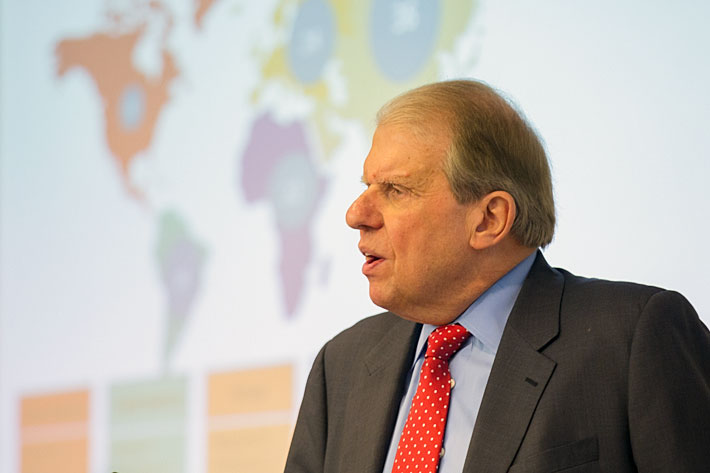At a time when federal research funding is in short supply, the George Washington University’s research expenditures from external resources—a key measure of an institution’s research activity—grew by nearly 11 percent from fiscal year 2013 to 2014, said Vice President for Research Leo Chalupa during his presentation at Friday’s Faculty Senate meeting.
“We are currently in the most challenging environment in terms of accruing extramural funding that we’ve ever been,” Dr. Chalupa said. “Our premier research universities have been pretty much on a flat line.”
A decade ago, the National Institutes of Health (NIH) funded nearly one third of proposed research projects, Dr. Chalupa said, but today NIH funds less than one sixth of proposed projects. Deep federal budget cuts in 2013 led to delays in delivering funds and cancellations of research projects at universities around the country.
While GW researchers have expressed frustration stemming from these cuts, Dr. Chalupa remained optimistic about the future of research at the university. In addition to the 11 percent jump in research expenditures, GW’s indirect costs from extramural sponsored projects also rose more than 7 percent in 2014 from the previous year.
Dr. Chalupa attributed much of the growth to “spectacular new faculty” whom the university has hired in the past few years. He added that the new Science and Engineering Hall, which opened this month, has been a “key factor” in attracting top professors.
“They see the kind of commitment that this university has made to the future. It has been a tremendous selling point, and I expect that will continue for a very long time to come,” Dr. Chalupa said.
Dr. Chalupa said GW’s global research efforts also are increasing. There are currently 104 international research projects in 50 different countries on every continent except Antarctica. More than 8 percent—79 of the university’s 957 ongoing research projects—have an international component. And around 12 percent of GW’s research expenditures are connected to international projects.
He said the Office of the Vice President for Research (OVPR) is looking to increase those numbers further in upcoming years and to help faculty explore sources of funding from international agencies. He announced that his office will give $5,000 travel grants for faculty wishing to take short-term trips in order to make connections with colleagues abroad.
“They’ll have to fill out a one-page proposal about who they’d like to collaborate with, what the topic is, and what the possible outcome of that is in terms of getting new grants,” Dr. Chalupa said.
Providing an update on GW’s 11 institutional initiatives, launched jointly between OVPR and the Office of the Provost, Dr. Chalupa said that director searches are in progress for the Autism and Neurodevelopmental Disorders Initiative, Big Data for Science and Engineering, Genomics and Cancer.
“We are going to be a regional leader in this area,” Dr. Chalupa said regarding the university’s efforts to invest in the growth of cancer research.
Following Dr. Chalupa’s presentation, some members of the Faculty Senate questioned the growth of research at GW. They expressed concern that, given the rate of inflation, the university’s indirect cost recovery has been growing at a slower pace than its research expenditures.
Dr. Chalupa and George Washington President Steven Knapp explained that indirect costs do not typically increase at the same rate as research expenditures for various reasons, including capital improvements or large foundation grants that may not receive full indirect cost recovery.
Dr. Knapp assured the Faculty Senate that “the upward trend is real.” But he suggested that Dr. Chalupa present more data in the future to respond to the concerns.
“At a time when most universities are either flat or declining, we have seen a steady growth that is beyond the rate of inflation,” Dr. Knapp said. “But we have to see those numbers so people understand the full picture.”
Bridging Research to Business
As research continues to grow at GW, more faculty innovations are finding their way into the marketplace than in years past, thanks to help from the Office of Technology Transfer, led by Director Steve Kubisen.
The office’s mission is to facilitate the transfer of laboratory research to companies, entrepreneurs and investors, Dr. Kubisen said at Friday’s meeting. He encouraged faculty whose research has “solved a problem” to contact the Office of Tech Transfer.
“We want a relationship,” Dr. Kubisen said. “We like to see your lab, we like to see what you’re doing and have that discussion so that we can determine is this patentable? Is it marketable? Should we invest in university funds to go ahead and file a patent and put our marketing effort behind it?”
From 2011 to 2014, licensing income that the university has received as a result of technology transfer has increased dramatically, Dr. Kubisen said.
For any idea that is successfully licensed, half of the royalties go to the inventor or inventors and the other half is distributed to the university and the inventor’s school or college to help fund further research activities.
But he stressed that the benefits of commercializing research innovations goes beyond the money.
“Why we do this is to solve problems, be it better patient care, lower energy costs or reduction in pollution,” Dr. Kubisen said. “We’d like to help you have impact in the world as well as potentially provide a lot of research funding back into your labs.”
Following Dr. Kubisen's presentation, Acting Chair of the Faculty Senate Fiscal Planning and Budgeting Committee Joseph Cordes outlined the university's year budget and revenue modeling.
The Faculty Senate also discussed whether video recordings should be allowed at meetings. The question was raised when a student brought in a camera and requested to record discussions last month. The executive committee is preparing a resolution that will outline when videotaping is permitted. Faculty Senate Executive Committee Chair Charles Garris said that some faculty members have had concerns that cameras may inhibit conversation. Each meeting is open to the GW community, and minutes are available online.


